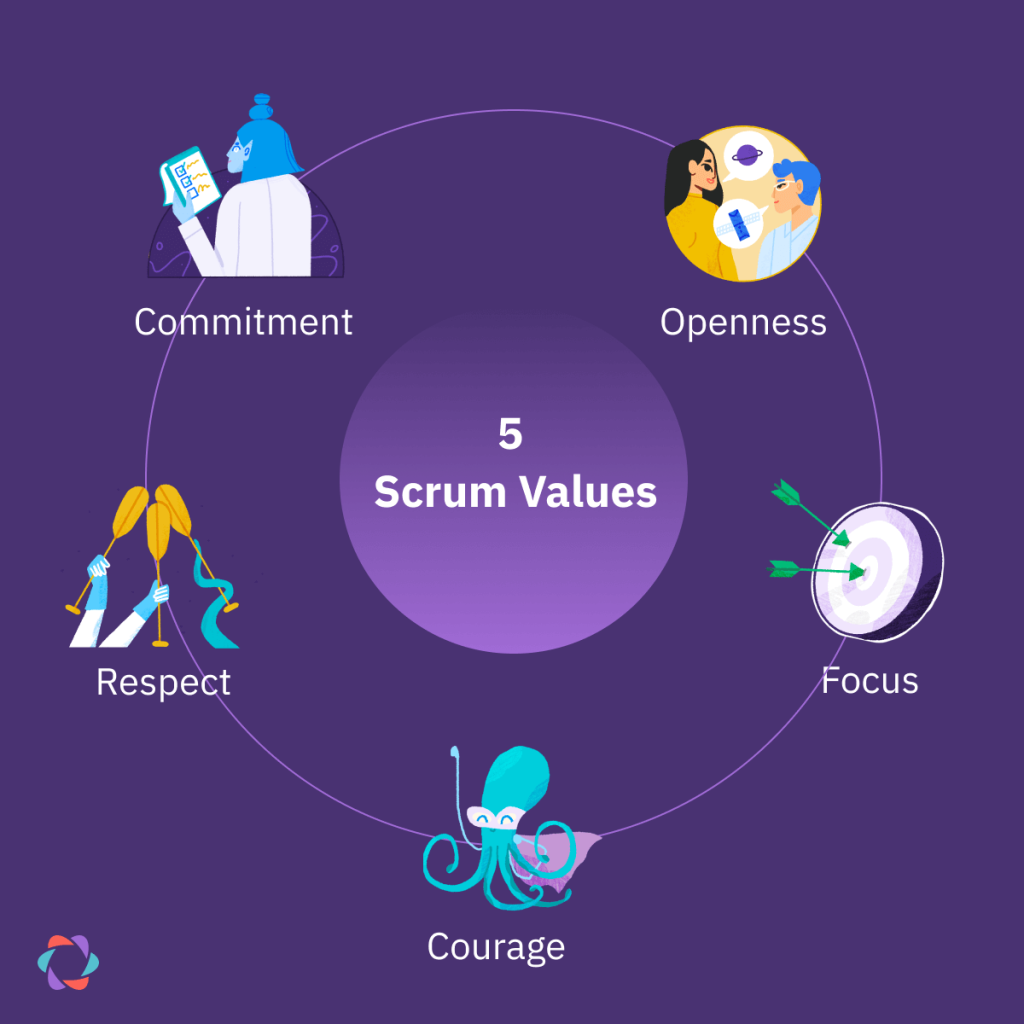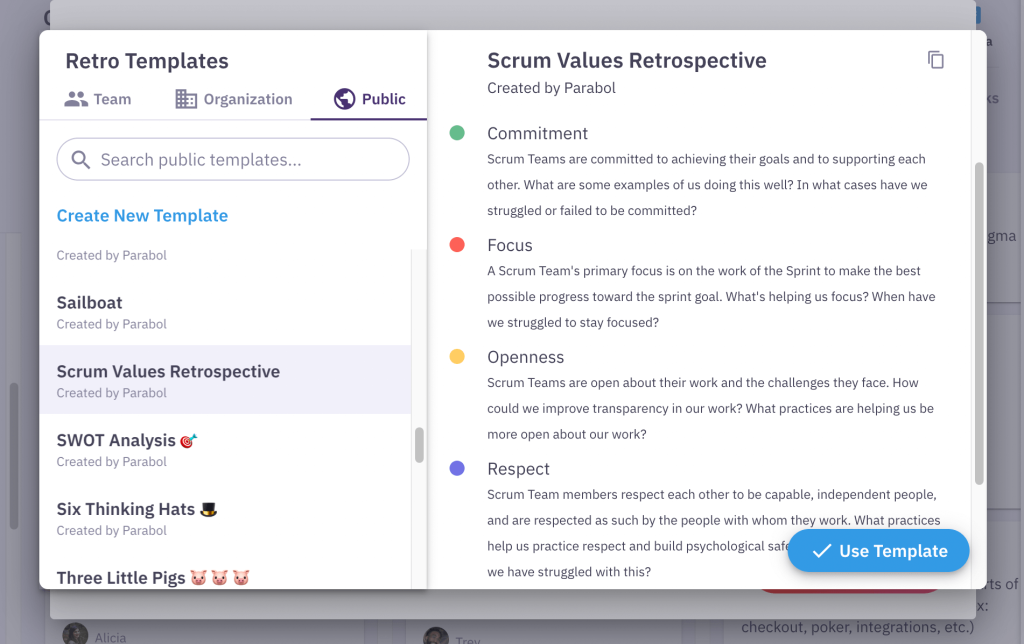The 5 Scrum Values Explained

Team values are useless if all they do is adorn posters on the office wall. But if people use them in their daily work, values guide teams in their decisions and actions. The Scrum values act as signposts for the Scrum framework. When team members work according to these values, they improve their performance.
Here’s an overview of what we cover in this blog:
What are the 5 Scrum values?
The 5 Scrum Values are:
- Commitment
- Focus
- Openness
- Respect
- Courage
The Scrum Values were first introduced to the Scrum Guide in 2016. The values are designed to guide the behaviors of the Scrum team.

We’ve included each of the Scrum values below with its original text from the guide, along with further background info and examples.
1. Commitment
“The Scrum Team commits to achieving its goals and to supporting each other.”
Any endeavor requires people to commit their expertise and time to goals and tasks. In Scrum, teams commit on a daily basis to take on roles, work, and challenges. A Scrum team’s Sprint Goals are set each sprint. Its product goals are set on a longer cadence.
📌 Examples of commitment in Scrum
- A team member commits to one of the three Scrum roles, which come with further commitments in the form of accountabilities.
- A team commits to achieving the Sprint Goal during Sprint Planning.
- Scrum teams commit to upholding a definition of done – a quality standard for their work.
- By holding regular retrospective events, teams commit to continuously improving themselves.
2. Focus
“Their primary focus is on the work of the Sprint to make the best possible progress toward these goals.”
When teams have focus, they complete work at high quality and speed. Focus also ensures people don’t waste time on unimportant matters. Scrum is designed to help teams enhance focus by reducing the need for ad hoc meetings that break flow.
📌 Examples of focus in Scrum
- Sprint and product goals help the team decide what work to focus on now and what to ignore.
- A Product Backlog ordered by the Product Owner creates focus by making clear which items to consider working on next.
- Timeboxed sprints and events limit the time to complete work and meetings, enforcing focus.
3. Openness
“The Scrum Team and its stakeholders are open about the work and the challenges.”
When team members hoard information or are afraid to discuss problems and concerns, a team can’t work autonomously. Since self-organizing teams are a tenet of agile ways of working, openness is an essential ingredient of Scrum.
📌 Examples of openness in Scrum
- The Product and Sprint Backlogs are accessible to anyone, making the plans and work of the team open. This transparency reduces the need for reports and ensures anyone can provide comments and suggestions.
- The Daily Scrum encourages openness among team members on a day-to-day basis about what they’re working on and how it’s going.
- The Scrum Board is shared and maintained by all team members in a visible place (or online), this means the status of tasks is open for all to see.
- Scrum events such as the Sprint Review and Sprint Retrospective require all participants to be open about mistakes, challenges, and other opportunities for continuous improvement.
4. Respect
“Scrum Team members respect each other to be capable, independent people, and are respected as such by the people with whom they work.”
Teamwork of any kind requires team members to respect each other. But, in Scrum, respect has to stretch beyond immediate coworkers to areas like the organization’s resources and customer needs.
📌 Examples of respect in Scrum
- Teams practicing Scrum respect the customer by focusing on the value they deliver to them, not a vanity metric like the number of shipped features or hours billed.
- The Scrum framework respects the development team by entrusting them to self-manage and determine how they’ll do their work to achieve the Sprint Goal.
- Scrum team members respect each other by following practices like the Prime Directive when going into retrospective meetings.
5. Courage
“The Scrum Team members have the courage to do the right thing, to work on tough problems.”
Complex undertakings come with many unknowns, teamwork involves disagreement, and continuously improving yourself and each other means leaving your comfort zone often. All these are aspects of Scrum that require courage.
📌 Examples of courage in Scrum
- Scrum minimizes the risk of failure to one Sprint. This characteristic gives people courage to try new things.
- Every team member needs courage to push back and say no to others who violate the Scrum framework or the team’s commitments.
- People need courage to admit mistakes, hold others accountable, and challenge themselves and others to always improve.
Why do the Scrum values matter?
Gunther Verheyen, author and veteran Scrum Trainer“Values drive behavior”
The roles, events, and artifacts that form Scrum help teams practice the Scrum values. They’re not an afterthought but the source of the framework. If teams don’t understand the values, they will struggle to understand the purpose of Scrum’s different elements and practices.
Say you hold a sprint retrospective, but nobody is open about mistakes they’ve made or noticed, nor does anyone have the courage to speak up about problems and challenges. In that case, the retrospective becomes useless.
Both individual team members and the organization in which they operate need to understand and support the values for Scrum to work.
Scrum’s five values also reinforce each other. For example, for a team to truly commit to a goal, they need to know everything that might affect their ability to achieve that objective. That, in turn, requires openness. And once team members know all the risks of a specific goal, they need courage to pursue it.
How to use the Scrum values
Reading and talking about values is one thing. But using them in your sprints is another. Here are five tips to help you apply Scrum’s values in your daily work.
- Believe in them. The team and broader organization must understand and buy into the five values. Dedicate workshops, 1:1s, and retrospectives to educate people about the values, answer questions, and remove doubts and concerns.
- Communicate them. Everyone should use the values in their interactions whenever there’s an opportunity to do so. For example, consider how you can avoid a mistake in the future with more focus or refer to the value of openness when someone else on the team shares bad but important news early.
- Live them. The entire Scrum team, but especially Scrum Masters and other agile coaches, should “live” the five values according to the Scrum Guide. Be the first to admit a mistake, show respect for the opinions of others, and show courage in the face of challenges. Set a positive example for others.
- Enable them. Embed the values in your daily work by following the Scrum process and using tools created with these ideas in mind, like Parabol’s retrospective and daily standup tool for remote teams.
- Protect them. Everyone – and the Scrum Master in particular – should fight to uphold Scrum’s values by removing impediments. Not just within the team but also with other folks in the organization and stakeholders that undermine the team’s ability to do so themselves.
Are you living the Scrum values?
We’ve created two tools to help you test how your current performance aligns with the Scrum values. One is a self-assessment test for individuals, and the other is a retrospective template you can run with your team.
Scrum values self-assessment
Take this 12-question quiz and find out to what extent you currently embody the Scrum values.
Scrum values team retrospective
You can hold a retrospective to determine how well your team lives the Scrum values. We’ve developed a unique Scrum values retrospective template you can use for this purpose.

Encourage team-mates to think about times when your team has acted in accordance with the Scrum values, and times when it’s been difficult to.
Scrum encourages teams to “learn and explore the values as they work with the Scrum events and artifacts”. Running a Scrum values retrospective is one of the best ways to do that.
Scrum values FAQs
Are the 5 Scrum values the same as the 3 Scrum pillars?
Scrum’s values and pillars are not the same.
- Scrum Values focus on behaviors that should guide the Scrum team
- Scrum Pillars are about the qualities Scrum processes should adhere to.
The Scrum values are commitment, focus, openness, respect, and courage. Its pillars are transparency, inspection, and adaptation.
🙏 Thanks to enterprise agile coach Melvin Pérez-Cedano for his insights on this distinction.
Which of the Scrum values is most demonstrated when a team completes a task before moving onto the next one?
Teams show focus by taking on one task and finishing it before picking another one. Some teams choose to use WIP limits to help preserve focus. WIP limits set a cap on how many tasks can be in progress at any one time. WIP limits are the third most helpful agile metric, according to our research.
Which Scrum values are affected by lack of trust?
A lack of trust undermines all Scrum Values. When there’s no trust, people don’t respect each other, making it harder for people to share concerns and mistakes openly. That, in turn, makes people scared and less courageous.









